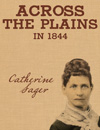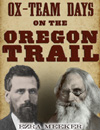Discoverers
Who really found the Oregon Trail?
In 1800, the American West was still wild country--no cities, no railroads and no cattle ranches yet existed. It was quiet and untouched. People in the eastern U.S.had heard stories about the western mountains and the desert, but no Euro-American had been there. Within a very short time that would all change.
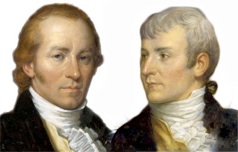
Lewis and Clark
In 1803, President Thomas Jefferson organized a secret mission to send a small party overland to the Pacific--a daunting trek that no one before had tried. Congress met covertly to approve the trip, because Lewis and Clark would be venturing beyond the United States--onto British soil.
Jefferson chose his old friend and neighbor Meriwether Lewis to lead the venture; and Lewis in turn picked rough-hewn frontiersman William Clark to be co-leader. In May of 1804, their contingent of a few dozen men started west up the Missouri River.
Jefferson's hope was that Lewis and Clark would find an easy water route to the Pacific--a simple way west for traders and emigrants alike. He also wanted Lewis and Clark to gather scientific information about the region--after all, no white man had seen the west's plants or animals.
The journey took so long, many assumed the expedition had perished. But on December fifth, 1805, Lewis and Clark reached the Pacific. William Clark wrote "We now discover that we have found the most practicable and navigable passage across the continent of North America." He was dead wrong.
Lewis and Clark's route was much too difficult for wagon traffic. No pioneer wagon would ever follow in their footsteps. Lolo Pass, where the expedition crossed the most difficult section of the Rockies, is a rough haul even today--almost two centuries later.
But their expedition was still considered a success. That's because their detailed maps and notes provided a wealth of solid scientific data. The West was a mystery no more.
The Astorians
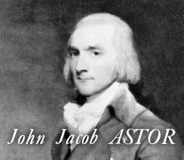 The second major westward expedition was not funded by the government; it was backed by the world's richest man--John Jacob Astor. Astor had read about Lewis and Clark's journey and by 1810 he saw an opportunity to make money. His plan was to set up a fur-trading enterprise at the mouth of the Columbia River. Just one problem--how to get his men across the uncharted American West. Astor sent two groups--the first traveled by ship around Cape Horn. They arrived safely, but their ship was later destroyed in a conflict with Native Americans in the area.
The second major westward expedition was not funded by the government; it was backed by the world's richest man--John Jacob Astor. Astor had read about Lewis and Clark's journey and by 1810 he saw an opportunity to make money. His plan was to set up a fur-trading enterprise at the mouth of the Columbia River. Just one problem--how to get his men across the uncharted American West. Astor sent two groups--the first traveled by ship around Cape Horn. They arrived safely, but their ship was later destroyed in a conflict with Native Americans in the area.
A second group traveled overland; the first to try since Lewis and Clark. But things did not go well. At Caldron Linn, a particularly rough spot on the Snake River, one of the overland party's canoes capsized--causing the death of one man and a substantial loss of supplies. Hunt soon discovered that the river did not become more placid downstream.
Reluctantly, he came to the inevitable conclusion--the Snake was unnavigable. There would be no easy water route to the Pacific; an unfortunate twist of geography that would frustrate pioneers for the next hundred years.
In the end, Hunt's overland party did make it to the Pacific, but the enterprise was in deep trouble. Their only hope was to send a few men back east to get help from Astor. Robert Stuart led the mission back to St. Louis--a difficult journey that took nearly a year.
Along the way, Stuart made an incredible discovery--he found a 20-mile wide gap in the Rocky mountains--the one passage where wagons could get through. Named South Pass, this find would become the key to western migration. Over a half-million emigrants would eventually follow the ruts through South Pass. Where Lewis and Clark had failed, Robert Stuart had unwittingly succeeded.
Pike & Long
Despite Stuart's discovery of a passage through the Rockies, it would be several decades before the big move west would begin. Why the delay? Part of the blame goes to Lt. Zebulon Pike. In 1806, Pike was sent west to explore the great plains and Rocky Mountains. Unfortunately, in his reports Pike referred to the plains as "the Great American Desert," a name that stuck. Even though much of the region is nothing like a desert, people back east conjured up images of sand dunes and cactus. No emigrant in their right mind would try to cross a severe wasteland--and so the big move west was delayed.
Pike's opinion that the west was a vast desert was confirmed by Maj. Steven Long, who led an expedition west in 1819. Long and his men passed through what is now Oklahoma, Nebraska, Colorado, Kansas and Oklahoma. He concluded that the entire region was unfit for human habitation.
And so the west remained largely untouched. Native American tribes lived in peace. White settlers stayed away. After all, the west was uninhabitable; at least that's what everyone thought.
Mountain Men
Despite the negative publicity, a few Americans did trickle west in the first few decades of the 19th century. They were a rough-hewn bunch of adventurous entrepreneurs--that came to be called "Mountain Men."
These solitary fur-trappers lived thousands of miles from civilization. Most had no home, no money and no possessions--except what they could carry on their backs. They lived completely off the land, with a diet of buffalo, elk and mountain goat. Many roamed constantly, covering hundreds, perhaps thousands of miles each year all in search of just one thing--beaver pelts. A mountain man could trade a beaver pelt for anything he needed--but then, he didn't need much.
Although it may seem like an exciting life, it was never easy. At night, they slept right on the ground and freezing winters were spent in a drafty teepee. An injured mountain man might have to set his own broken bone or even amputate his own limb. Their only friends were the Native Americans they occasionally met.
Even before Lewis and Clark finished their epic journey to the Pacific, mountain men were traveling up and down the Missouri River in search of beaver fur. Most importantly, they were pushing the limits of known civilization; exploring new lands and discovering uncharted places.
In 1808, mountain man John Colter stumbled upon a land where hot water shot straight into the air and the earth bubbled as if it were boiling. He had discovered the place we now know as Yellowstone National Park. But no one believed him. They thought he was telling tall tales.
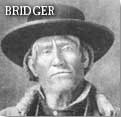 Similarly--on a bet--mountain man Jim Bridger sailed down the Bear River in Utah until he found a huge body of salt water. He thought he had reached the Pacific Ocean. In reality, Bridger had discovered the Great Salt Lake. Bridger was one of the best known mountain men; largely for his trailblazing skills. In one adventure he took an arrowhead in the back. He finally had it removed three years later--without anesthetic.
Similarly--on a bet--mountain man Jim Bridger sailed down the Bear River in Utah until he found a huge body of salt water. He thought he had reached the Pacific Ocean. In reality, Bridger had discovered the Great Salt Lake. Bridger was one of the best known mountain men; largely for his trailblazing skills. In one adventure he took an arrowhead in the back. He finally had it removed three years later--without anesthetic.
Later in life--in the 1840s--Bridger built a fort in what is now Wyoming. His goal was to sell supplies to the flood of emigrants then heading for Oregon. But the fort tied him down, and so within a few years, Bridger sold his fort and got back to the only lifestyle he knew--adventure.
Perhaps the greatest mountain man of them all was Jedediah Smith. Incredibly tough, he once sewed on his scalp after an angry bear had torn it off. In 1825, Smith re-discovered South Pass--a key passageway through the treacherous Rocky Mountains. South Pass had been visited by an earlier explorers but its location had been kept secret. Smith made sure everyone knew about this important corridor.
But Smith's greatest achievement was his epic expedition to the Southwest. In 1826 he set out from the Great Salt Lake--intent on visiting lands no white man had seen. He would spend the next four years fulfilling that dream. Smith's journeys took him from what is now Canada to Mexico--but it wasn't his route that was important. After all, no settler ever followed his path. What was important was the map he left behind--the so-called "Fremont-Gibbs-Smith map" was the only accurate and comprehensive map of the era. It would be decades before a better guide to the American West would be available.
 The only mountain man who could rival the greatness of Jedediah Smith was Joe Walker. For over half a century he roamed the west, trapping beaver, blazing trails, and leading expeditions. Perhaps Walker's greatest triumph was the trail he blazed to California in 1832. But Walker wasn't alone, he was under the employ of a US army captain-- Benjamin Bonneville. Bonneville claimed he was on leave from the army to take up fur trapping, but many historians think he was an undercover agent for the US government--sent to spy on the Mexicans in California. We'll never know for sure.
The only mountain man who could rival the greatness of Jedediah Smith was Joe Walker. For over half a century he roamed the west, trapping beaver, blazing trails, and leading expeditions. Perhaps Walker's greatest triumph was the trail he blazed to California in 1832. But Walker wasn't alone, he was under the employ of a US army captain-- Benjamin Bonneville. Bonneville claimed he was on leave from the army to take up fur trapping, but many historians think he was an undercover agent for the US government--sent to spy on the Mexicans in California. We'll never know for sure.
It is sure, however, that the route blazed by Bonneville and Walker was critically important because it turned out to be the only practical route to California. In future years hundreds of thousands of pioneers would follow their footsteps to the promised land. Nearly a half-century later, the transcontinental railroad--seeking the best route west--would lay their tracks directly on top of Joe Walker's trail to California.
Fur Trading Companies
Early on, at least one American saw there was money to be made by organizing the mountain men into large fur trading companies. His name was Manuel Lisa. Ruthless and violent, Lisa was hated by his men but he was a very successful businessman. Starting in 1807, he quickly built a chain of forts along the Missouri and his men fanned out in all directions to harvest the abundant beaver.
Hoping for similar success, William Ashley, in 1822, put an ad in a St. Louis paper, to recruit able-bodied men for his new enterprise. There was no shortage of willing young men.
Unlike Lisa, Ashley did not build a chain of forts to manage his fur trading operation. Instead, he sent his men out alone and made arrangements to meet them all at a centrally-located place a year later. At the pre-determined time, Ashley would load up his wagons with supplies to replenish his men and then head off to meet them. Ashley's yearly journey began in St. Louis and took him deep into the heart of the Rockies. Importantly, his wagons were the first vehicles to penetrate the west. He was, unknowingly, blazing a wagon road for the settlers who would follow a decade later.
When Ashley finally reached his men each year, it was cause for celebration--a wild party they called "the rendezvous." Every year throughout the 1820s and 30s it was the same: gambling, drinking, storytelling that went on for days.
Ashley and his successors got rich, but his trappers largely got fleeced. Nonetheless, the interplay was critical--because the Ashley took important information about the West back to civilization.
By the late 1830s, beaver hats were going out of style in New York and London, and so pelts were no longer in demand. As a result, many mountain men were forced to find a new livelihood. Some became farmers, others led pioneer wagons trains--that were just now beginning to stream west. The era of the mountain man had passed and the age of the pioneer was beginning.
Fremont
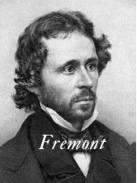 Explorer John Fremont became one of America's biggest heroes because of his journeys west along the Oregon Trail in 1842 and 1843. He got the job largely because his wife's father was the powerful Missouri senator Thomas Hart Benton. Benton believed America had an innate right to all the lands of the west, an idea that came to be called "Manifest Destiny." And so Fremont was under strict orders to make the west seem attractive--worth settling. That he did. Fremont's reports on his journeys were decidedly upbeat. They made the trip west seem easy--enjoyable. The reports were widely read in the east, stirring up excitement and encouraging pioneers to head west.
Explorer John Fremont became one of America's biggest heroes because of his journeys west along the Oregon Trail in 1842 and 1843. He got the job largely because his wife's father was the powerful Missouri senator Thomas Hart Benton. Benton believed America had an innate right to all the lands of the west, an idea that came to be called "Manifest Destiny." And so Fremont was under strict orders to make the west seem attractive--worth settling. That he did. Fremont's reports on his journeys were decidedly upbeat. They made the trip west seem easy--enjoyable. The reports were widely read in the east, stirring up excitement and encouraging pioneers to head west.
However, even though the reports bear his name, Fremont didn't write them. He gave up and left the work to his wife--the intelligent and articulate Jesse Benton Fremont. It was she--as much as anyone--who lit the spark of America's big move west.

